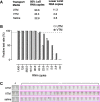Direct detection of SARS-CoV-2 RNA using high-contrast pH-sensitive dyes
- PMID: 35027870
- PMCID: PMC8730524
- DOI: 10.7171/jbt.21-3203-007
Direct detection of SARS-CoV-2 RNA using high-contrast pH-sensitive dyes
Abstract
The worldwide coronavirus disease 2019 pandemic has had devastating effects on health, healthcare infrastructure, social structure, and economics. One of the limiting factors in containing the spread of this virus has been the lack of widespread availability of fast, inexpensive, and reliable methods for testing of individuals. Frequent screening for infected and often asymptomatic people is a cornerstone of pandemic management plans. Here, we introduce 2 pH-sensitive "LAMPshade" dyes as novel readouts in an isothermal Reverse Transcriptase Loop-mediated isothermal AMPlification amplification assay for severe acute respiratory syndrome coronavirus 2 RNA. The resulting JaneliaLAMP assay is robust, simple, inexpensive, and has low technical requirements, and we describe its use and performance in direct testing of contrived and clinical samples without RNA extraction.
Keywords: LAMPshade; RT-LAMP; Si-fluorescein; carbofluorescein.
© 2021 ABRF.
Figures







References
Publication types
MeSH terms
Substances
LinkOut - more resources
Full Text Sources
Other Literature Sources
Medical
Miscellaneous
